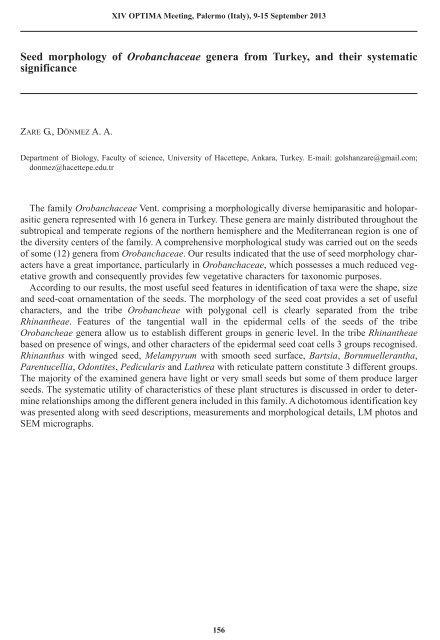Abstracts, XIV OPTIMA Meeting, Palermo (Italy) , 9-15
Abstracts, XIV OPTIMA Meeting, Palermo (Italy) , 9-15
Abstracts, XIV OPTIMA Meeting, Palermo (Italy) , 9-15
Create successful ePaper yourself
Turn your PDF publications into a flip-book with our unique Google optimized e-Paper software.
<strong>XIV</strong> <strong>OPTIMA</strong> <strong>Meeting</strong>, <strong>Palermo</strong> (<strong>Italy</strong>), 9-<strong>15</strong> September 2013<br />
Seed morphology of Orobanchaceae genera from Turkey, and their systematic<br />
significance<br />
ZARE G., DÖNMEZ A. A.<br />
Department of Biology, Faculty of science, University of Hacettepe, Ankara, Turkey. E-mail: golshanzare@gmail.com;<br />
donmez@hacettepe.edu.tr<br />
The family Orobanchaceae Vent. comprising a morphologically diverse hemiparasitic and holoparasitic<br />
genera represented with 16 genera in Turkey. These genera are mainly distributed throughout the<br />
subtropical and temperate regions of the northern hemisphere and the Mediterranean region is one of<br />
the diversity centers of the family. A comprehensive morphological study was carried out on the seeds<br />
of some (12) genera from Orobanchaceae. Our results indicated that the use of seed morphology characters<br />
have a great importance, particularly in Orobanchaceae, which possesses a much reduced vegetative<br />
growth and consequently provides few vegetative characters for taxonomic purposes.<br />
According to our results, the most useful seed features in identification of taxa were the shape, size<br />
and seed-coat ornamentation of the seeds. The morphology of the seed coat provides a set of useful<br />
characters, and the tribe Orobancheae with polygonal cell is clearly separated from the tribe<br />
Rhinantheae. Features of the tangential wall in the epidermal cells of the seeds of the tribe<br />
Orobancheae genera allow us to establish different groups in generic level. In the tribe Rhinantheae<br />
based on presence of wings, and other characters of the epidermal seed coat cells 3 groups recognised.<br />
Rhinanthus with winged seed, Melampyrum with smooth seed surface, Bartsia, Bornmuellerantha,<br />
Parentucellia, Odontites, Pedicularis and Lathrea with reticulate pattern constitute 3 different groups.<br />
The majority of the examined genera have light or very small seeds but some of them produce larger<br />
seeds. The systematic utility of characteristics of these plant structures is discussed in order to determine<br />
relationships among the different genera included in this family. A dichotomous identification key<br />
was presented along with seed descriptions, measurements and morphological details, LM photos and<br />
SEM micrographs.<br />
<strong>15</strong>6






